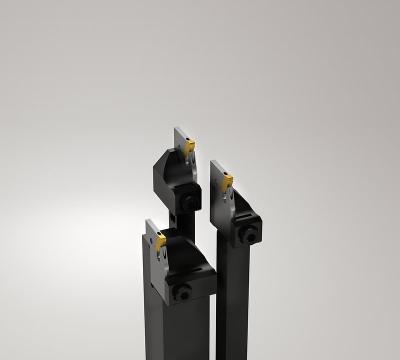
New additions to JETI (Jetstream Integrated) tooling from Seco Tools eliminate coolant-through tooling and connector interference that hinders grooving, parting-off and other turning operations. With interference-free internal coolant capabilities and the option to switch the underside stream channel on and off as required, these expansions to the range of MDT (Multiple-Directional Turning) X4 (grooving and parting-off) and 150.10 (parting-off) toolholders add operational stability and reliability while they improve surface finishes.
To optimize machining, chip control and process reliability, Jetstream Tooling aims high-pressure coolant directly into the cutting zone through internal channels in the toolholder. Unlike other tool holders, Jetstream Tooling Duo incorporates upper and lower cooling channels, with the ability to activate the underside stream as needed. Side and back coolant connections enable these holders to function on machines with conventional coolant supplies.
Jetstream Tooling provides application flexibility and the productive convenience of coolant delivery without external hoses, fittings and spare parts that can diminish productivity and raise costs. Square-shanked MDT, X4 and 150.10 holders are available in 20 mm x 20 mm and 25 mm x 25 mm sizes. MDT holders accept inserts in 2, 3, 4, 5, 6 and 8 mm. 105.10 holders accept 15-size blades.
Contact Details
Related Glossary Terms
- coolant
coolant
Fluid that reduces temperature buildup at the tool/workpiece interface during machining. Normally takes the form of a liquid such as soluble or chemical mixtures (semisynthetic, synthetic) but can be pressurized air or other gas. Because of water’s ability to absorb great quantities of heat, it is widely used as a coolant and vehicle for various cutting compounds, with the water-to-compound ratio varying with the machining task. See cutting fluid; semisynthetic cutting fluid; soluble-oil cutting fluid; synthetic cutting fluid.
- grooving
grooving
Machining grooves and shallow channels. Example: grooving ball-bearing raceways. Typically performed by tools that are capable of light cuts at high feed rates. Imparts high-quality finish.
- toolholder
toolholder
Secures a cutting tool during a machining operation. Basic types include block, cartridge, chuck, collet, fixed, modular, quick-change and rotating.
- turning
turning
Workpiece is held in a chuck, mounted on a face plate or secured between centers and rotated while a cutting tool, normally a single-point tool, is fed into it along its periphery or across its end or face. Takes the form of straight turning (cutting along the periphery of the workpiece); taper turning (creating a taper); step turning (turning different-size diameters on the same work); chamfering (beveling an edge or shoulder); facing (cutting on an end); turning threads (usually external but can be internal); roughing (high-volume metal removal); and finishing (final light cuts). Performed on lathes, turning centers, chucking machines, automatic screw machines and similar machines.

